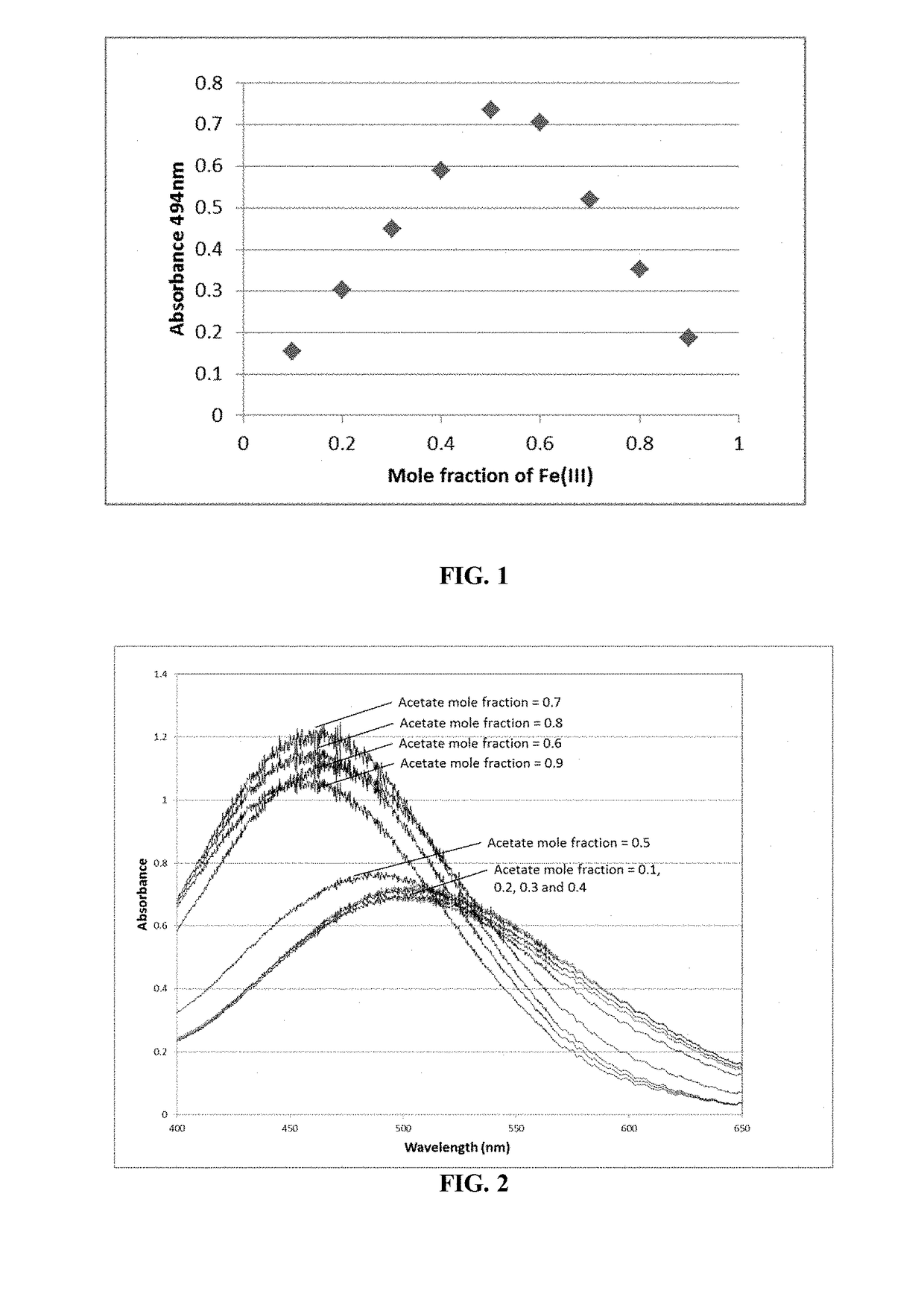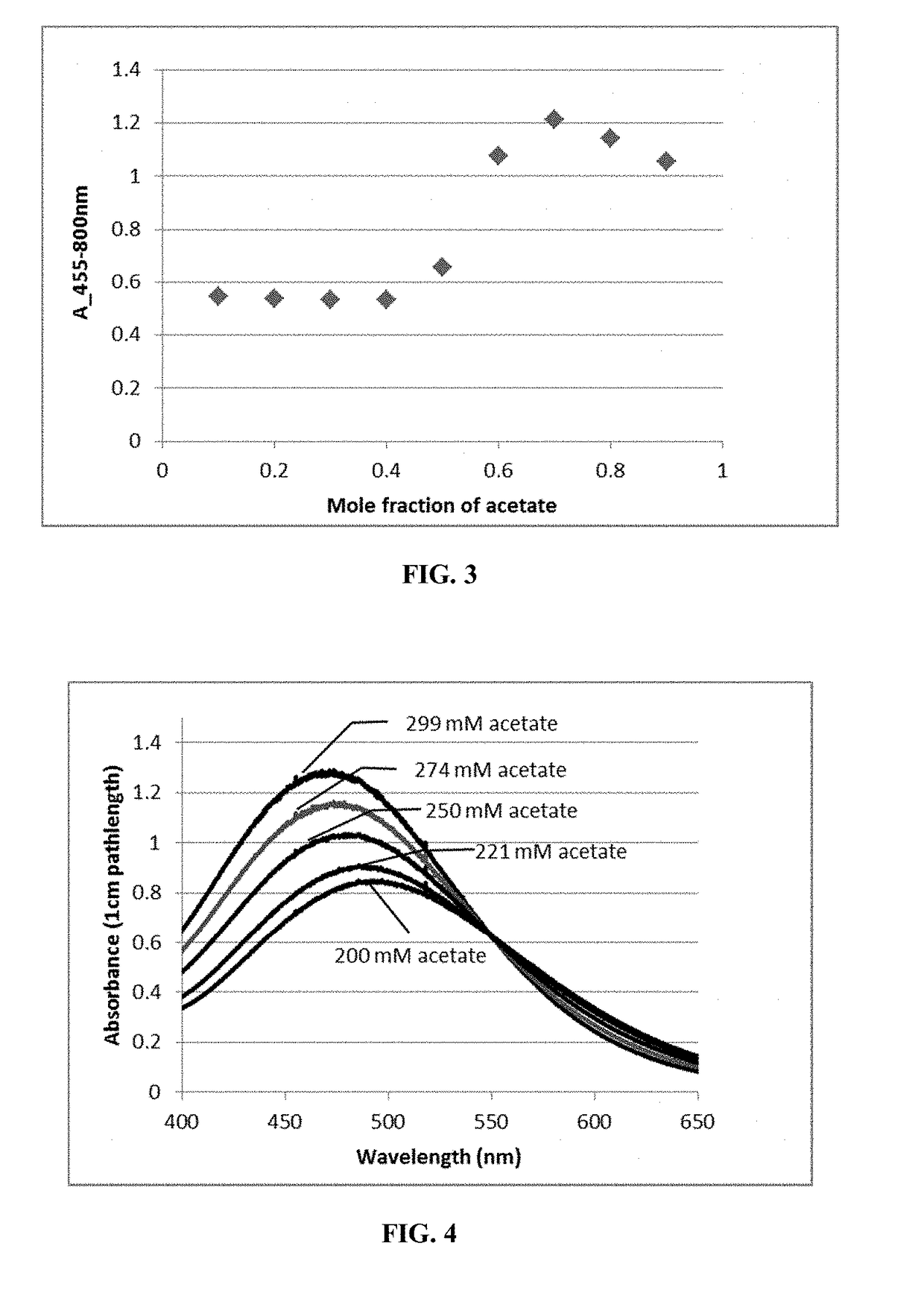Acetate complexes and methods for acetate quantification
a technology of acetate complexes and acetate assays, which is applied in the field of methods of acetate quantification and acetate complexes, can solve the problems of inability to quantify hyperpolarized acetate, time-consuming enzyme-based acetate assay methods, and short life span of hyperpolarized imaging agents, and achieve quick and accurate acetate quantification, convenient use of water as a solven
- Summary
- Abstract
- Description
- Claims
- Application Information
AI Technical Summary
Benefits of technology
Problems solved by technology
Method used
Image
Examples
example 1
Job Plot of Fe / SSA Complex
[0076]Fe3+ / SSA complex formation has been commonly used as a colorimetric method for iron quantification. Iron and SSA form a 1:1 violet complex in acidic media and shift to orange and yellow color as pH increases to neutral and basic range. In our studies, Fe / SSA reagents were prepared in water solutions which are acidic due to presence of SSA. Varying volumes of 1 mM Fe3+ were mixed with 1 mM SSA solution, total volume was kept constant at 2 mL. The total molar concentration of Fe3+ and SSA were held constant. An Ocean Optics fiber optics spectrometer set up and a UV-Vis light source were used for absorbance measurement. A Job plot was obtained by measuring the absorbance change with continuous varying of the mole ratio of Fe3+, as shown in FIG. 1. For example, at Fe(III) ratio of 0.2, 0.4 mL 1 mM Fe3+ was mixed with 1.6 mL 1 mM SSA solution. The peak absorbance at 490 nm reached a maximum at 0.5 mole ratio, which corresponds to 1:1 stoichiometry of Fe3+ ...
example 2
Acetate, Fe3+, and SSA Mixture Study
[0077]Mixing Fe3+ with acetate alone did not generate any color, which was expected. Reagent A (0.5 mM Fe3+, 200 mM acetate) and reagent B (0.5 mM Fe3+, 200 mM SSA) were mixed at varying mole ratios to study mixtures of acetate, Fe3+, and SSA. For example, at mole ratio of acetate at 0.2, 0.4 mL reagent A was mixed with 1.6 mL reagent B. Iron concentration was kept constant with respect to the total concentration of the combination of SSA and acetate. The results are shown in FIG. 2. As could be seen in FIG. 2, when the mole fraction of acetate was less than 0.5, the absorbance spectra had absorbance maximum at 490 nm, which was consistent with Fe / SSA complex absorbance. With increasing mole fraction of acetate, the absorbance maximum shifted to 470 nm. The peak absorbance increased first, then decreased once the mole fraction was bigger than 0.7. The data points within the mole fraction range of 0.5 to 1.0 were fitted with second degree polynomia...
example 3
Preparation of Acetate / Fe / SSA Complex
[0079]Fe3+ and sulfosalicylic acid (“SSA”) reagent (“Fe / SSA reagent”) was prepared by dissolving FeCl3 and 5-sulfosalicylic acid dihydrate in water to a final concentration of 0.65 mM Fe3+ and 200 mM SSA. The Fe / SSA reagent solution was acidic due to presence of SSA.
[0080]Acetate standards were prepared by dilution of acetic acid to basic buffers containing Tris and sodium hydroxide. For example, 5 g acetic acid was mixed with 83.6 g basic buffers (720 mM NaOH and 400 mM TRIS), and 110 g dilution medium (0.1% EDTA in water) to make final acetate stock solution of ˜410 mM acetate stock solution at pH 7.6. The acetate stock solution was then diluted with dilution medium to make 200-300 mM acetate samples as needed.
[0081]Solutions of an acetate complex of acetate, Fe3+ and SSA (“acetate / Fe / SSA complex”), were prepared by mixing the Fe / SSA reagent solutions (1 mL) with aqueous solutions of acetate standards (1 mL) in 1:1 volume ratio.
PUM
| Property | Measurement | Unit |
|---|---|---|
| light wavelength | aaaaa | aaaaa |
| light wavelength | aaaaa | aaaaa |
| light wavelength | aaaaa | aaaaa |
Abstract
Description
Claims
Application Information
 Login to View More
Login to View More - R&D
- Intellectual Property
- Life Sciences
- Materials
- Tech Scout
- Unparalleled Data Quality
- Higher Quality Content
- 60% Fewer Hallucinations
Browse by: Latest US Patents, China's latest patents, Technical Efficacy Thesaurus, Application Domain, Technology Topic, Popular Technical Reports.
© 2025 PatSnap. All rights reserved.Legal|Privacy policy|Modern Slavery Act Transparency Statement|Sitemap|About US| Contact US: help@patsnap.com



